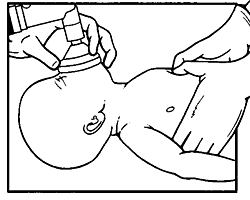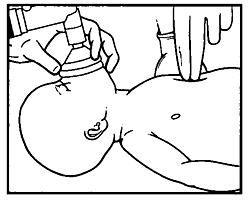Circulation
1.7.3. Circulation
|
Assessment of heart rate
- The heart rate of most uncompromised newborns will rise to above 100 beat per minute (bpm) within a minute of birth without any intervention.
- Recent studies show that some uncompromised newborns do not achieve a heart rate above 100 bpm by one minute of age, however if they are breathing effectively and have good muscle tone, no intervention is required (Dawson et al, 2010).
- The heart rate can be measured by auscultation over the apex with a stethoscope, palpation of the umbilicus or by ECG monitoring or pulse oximetry.
- When compared with ECG monitoring, auscultation of the heart rate for 6 seconds and multiplying this number by 10 has been shown to underestimate the heart rate by an average of 14 beats per minute. Palpation of the umbilical cord is even less reliable, underestimating the heart rate by an average of 22 beats per minute (Kamlin et al, 2006). Underestimation of the heart rate may result in an infant receiving positive pressure ventilation unnecessarily.
- A pulse oximeter, applied to the right hand or wrist, can provide an accurate measurement of heart rate approximately 50 seconds after the sensor is applied and connected to the oximeter cable.
- Effective positive pressure ventilation alone will normally result in a rapid improvement in heart rate.
Indications for external chest compressions (ECC)
Chest compressions are indicated whenever the heart rate remains below 60 bpm despite 30 seconds of effective positive pressure ventilation.
Newborn infants whose heart rate drops to below 60 bpm are usually hypoxic and acidotic. If the heart rate remains low, the circulation will be inadequate to support tissue oxygenation. As the myocardium is depressed, it cannot contract strongly enough to pump blood to the lungs to be oxygenated. Chest compressions (external chest compressions or ECC) are a means of mechanically pumping blood through the heart in conjunction with positive pressure ventilation until the myocardium becomes sufficiently oxygenated to recover spontaneous function. The provision of chest compressions with positive pressure ventilation will also assist in providing oxygen to the brain (Kattwinkel, 2006).
Note: The FiO2 should be increased to 100% whenever chest compressions are required
Techniques of external chest compressions
There are two techniques for providing external chest compressions to a newly born infant: the two thumb, hand encircling technique and the two finger technique. The two thumb, hand encircling technique is recommended as it results in:
- Higher blood pressure and coronary perfusion in swine & manikin models (Menegazzi et al, 1993)
- Sustains a consistent quality of compression for longer
- Requires less force to generate the same pressure as the two finger technique
- Easier and less draining on the resuscitator
Chest compressions over the lower third of the sternum are more effective than mid sternal compressions as the centre of most babies hearts has been found to lie under the lower third of the sternum. (Orlowski, 1986)
The two thumb, hand encircling technique (recommended technique for newborn resuscitation).
- Place two thumbs on the lower third of the sternum, (one finger breadth below an imaginary line drawn between the nipples) with the thumbs superimposed onto one another or side by side with the fingers encircling the infant’s torso to support the back (Figure 3).

Figure 3: The hand encircling, two thumb technique. (Reference: Kattwinkel, 2006, p. 4-5. )
The two finger technique
- Place two fingers onto the lower third of the sternum, using the pads of the second and middle finger to compress the chest (Figure 4).

Figure 4: The two finger technique. (Reference: Kattwinkel, 2006, p. 4-5)
Depth of compressions
- In both techniques, the aim is to compress one third of the anterior-posterior diameter of the chest.
- The infant must be positioned supine on a firm, flat surface for chest compressions to be effective.
Rate of compressions to ventilation
- Chest compressions (ECC) should be provided with positive pressure ventilation at a ratio of 3:1 to achieve 90 compressions and 30 inflations every minute (i.e. approximately 120 “events” per minute, with each event lasting approximately 0.5 seconds). This timing is based on experience and there is no compelling evidence suggesting a benefit to other ratios for the newborn. (ANZCOR, 2016, Guideline 13.6)
- The person providing the chest compressions should verbalise (out loud):
“One – and – two – and – three – and – breathe, one – and – two – and – three – and – breathe.”
- The three compressions are given in time with the “one – and – two- and – three – and” and the positive pressure inflation is given on the “breathe.”
- Verbalising the actions is designed to ensure that compressions and inflations do not occur simultaneously i.e. the chest should not be compressed when the positive pressure inflation is being delivered.
- The chest should fully expand between compressions.
- Chest compressions should continue until it is obvious that the heat rate is above 60 bpm and continuing to rise. (ANZCOR, 2016, Guideline 13.6)
Indications for advanced resuscitation interventions
If the infant’s heart rate does not rise above 60 beats per minute with effective chest compressions and positive pressure ventilation in 100% oxygen, then advanced resuscitation interventions, including drug administration, are now indicated.
The administration of drugs requires that the infant has intravenous access or an endotracheal tube in-situ. The indications for drug administration, intubation and umbilical vessel catheterisation are explored in the next section of this learning module. Whilst completion of this section of Learning Module 1 is not a compulsory pre-requisite for the First Response program, participants are strongly encouraged to review the key concepts of advanced resuscitation interventions before completing Learning Module 4: Post Resuscitation Care.
Participants undertaking the Advanced Resuscitation program should continue reading the following sections of this learning module: Advanced resuscitation interventions, resuscitation in special circumstances and discontinuation and/or withdrawal of resuscitation efforts.
| Previous | Next- Advanced Resuscitation |
